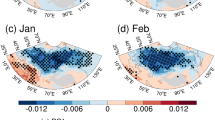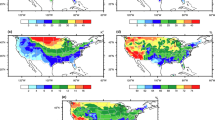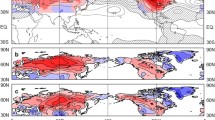Abstract
In this study, we investigate the dominant modes of surface air temperature variations of the cold season (from November through to the next March) and the warm season (from May to September) over Central Asia, and their associations with large-scale climate patterns for the period of 1979–2016. The first two modes of the cold season surface air temperature (CSAT) over Central Asia, obtained by empirical orthogonal function (EOF) analysis, feature the monopole structure and the north-south dipole pattern, respectively. For the warm season surface air temperature (WSAT), the leading two EOF modes are characterized by the homogenous structure and the northwest-southeast seesaw pattern, respectively. Further analysis indicates that the large-scale atmospheric circulation anomalies play key roles in the CSAT and WSAT variations over Central Asia. The CSAT variation over Central Asia is closely related to the Scandinavia pattern (SCAND) and the Arctic Oscillation (AO), while the WSAT variation is tightly tied to the East Atlantic/Western Russia pattern (EAWR) and the North Atlantic Oscillation (NAO). These large-scale climate patterns tend to cause the CSAT and WSAT anomalies over Central Asia via their effects on regional geopotential heights, warming advections, and other processes. Positive geopotential height anomalies and increased downward solar radiations generally favor positive SAT anomalies over Central Asia. Moreover, the warm advections are also conducive to the formation of positive SAT anomalies over Central Asia. Our findings are expected to facilitate the improvement of understanding and predicting the CSAT and WSAT variations over Central Asia.




















Similar content being viewed by others
Data availability
The CRU TS4.01 data is available at https://crudata.uea.ac.uk/cru/data/hrg/. The large-scale atmospheric indices are stored at https://www.esrl.noaa.gov/psd/data/climateindices/list/. The monthly ERA-5 reanalysis atmospheric circulation variables of 500-hPa geopotential height, 850-hPa wind vector, and air temperature at 850-hPa are available at https://cds.climate.copernicus.eu/cdsapp#!/dataset/reanalysis-era5-pressure-levels-monthly-means?tab=form. The NCEP-DOE AMIP-II reanalysis data is available at https://psl.noaa.gov/data/gridded/data.ncep.reanalysis2.gaussian.html.
Code availability
The code that supports the findings of this study is not available.
References
Barnston AG, Livezey RE (1987) Classification, seasonality and persistence of low frequency atmospheric circulation patterns. Mon Weather Rev 115(6):1083–1126
Besselaar EJMVD, Tank AMGK, Schrier GVD (2010) Influence of circulation types on temperature extremes in Europe. Theoretical & Applied Climatology 99(3):431–439
Chen F, Wang J, Jin L, Zhang Q (2009) Rapid warming in mid-latitude central Asia for the past 100 years. Front Earth Sci 3(1):42–50
Chen F, An C, Dong G, Zhang D (2017) Human activities, environmental changes, and rise and decline of Silk Road civilization in Pan-Third Pole region. Bulletin of Chinese Academy of Sciences (in Chinese) 32(9):967–975
Chen S, Wu R, Song L, Chen W (2018) Combined influence of the Arctic Oscillation and the Scandinavia pattern on spring surface air temperature variations over Eurasia. J Geophys Res-Atmos 123(17):9410–9429
Chen S, Wu R, Song L, Chen W (2019) Interannual variability of surface air temperature over mid-high latitudes of Eurasia during boreal autumn. Clim Dyn 53:1805–1821
Gong D, Wang S, Zhu J (2001) East Asian winter monsoon and Arctic oscillation. Geophys Res Lett 28(10):2073–2076
Guo YP, Li JP (2016) Impact of ENSO events on the interannual variability of Hadley circulation extents in boreal winter. Adv Clim Chang Res 7(1):46–53
Harris I, Jones PD, Osborn TJ, Lister DH (2014) Updated high-resolution grids of monthly climatic observations - the CRU TS3.10 Dataset. Int J Climatol 34(3):623–642
Hersbach H, Bell W, Berrisford P, Horányi AJM-S, Nicolas J, Radu R, Schepers D, Simmons A, Soci C, Dee D (2019) Global reanalysis: goodbye ERA-Interim, hello ERA5. ECMWF Newsletter 159:17–24
Hoy A, Sepp M, Matschullat J (2013) Large-scale atmospheric circulation forms and their impact on air temperature in Europe and northern Asia. Theoretical & Applied Climatology 113(3):643–658
Hu Z, Zhang C, Hu Q, Tian H (2014) Temperature changes in Central Asia from 1979 to 2011 based on multiple datasets. J Clim 27(3):1143–1167
Hu Z, Zhou Q, Chen X, Qian C, Wang S, Li J (2017) Variations and changes of annual precipitation in Central Asia over the last century. Int J Climatol 37(Suppl. 1):157–170
Huang JP, Li Y, Fu C, Chen F, Fu Q, Dai A, Shinoda M, Ma Z, Guo W, Li Z, Zhang L, Liu Y, Yu H, He Y, Xie Y, Guan X, Ji M, Lin L, Wang S, Yan H, Wang G (2017) Dryland climate change: recent progress and challenges. Rev Geophys 55(3):719–778
Hurrell JW, Van Loon H (1997) Decadal variations in climate associated with the Northampton oscillation. Clim Chang 36:301–326
IPCC (2013) Summary for policymakers. Fifth Assessment Report of the Intergovernmental Panel on Climate Change. Cambridge University Press, Cambridge
Kanamitsu M, Ebisuzaki W, Woollen J, Yang SK, Hnilo J, Fiorino M, Potter G (2002) NCEP–DOE AMIP-II reanalysis (R-2). Bull Am Meteorol Soc 83(11):1631–1643
Koide H, Kodera K (1999) A SVD analysis between the winter NH 500-hPa height and surface temperature fields. J Meteorol Soc Jpn 77(1):47–61
Li JP, Wang JXL (2003) A new North Atlantic Oscillation index and its variability. Adv Atmos Sci 20(5):661–676
Lioubimtseva E, Henebry CM (2009) Climate and environmental change in arid Central Asia: impacts, vulnerability, and adaptations. J Arid Environ 73(11):963–977
Lioubimtseva E, Cole R, Adams JM, Kapustin G (2005) Impacts of climate and land-cover changes in arid lands of Central Asia. J Arid Environ 62(2):285–308
Liu YY, Wang L, Zhou W, Chen W (2014) Three Eurasian teleconnection patterns: spatial structures, temporal variability, and associated winter climate anomalies. Clim Dyn 42(11):2817–2839
Luo M, Liu T, Meng F, Duan Y, Bao A, Frankl A, Maeyer PD (2019) Spatiotemporal characteristics of future changes in precipitation and temperature in Central Asia. Int J Climatol 39(3):1571–1588
Ren H, Zuo J, Jin FF, Stuecker MF (2015) ENSO and annual cycle interaction: the combination mode representation in CMIP5 models. Clim Dyn 46(11):3753–3765
Santoso A, Mcphaden MJ, Cai W (2017) The defining characteristics of ENSO extremes and the strong 2015/16 El Niño: ENSO extremes. Rev Geophys 55(4):1079–1129
Steinbrecht W, Claude H, Köhler U, Winkler P (2001) Interannual changes of total ozone and Northern Hemisphere circulation patterns. Geophys Res Lett 28(7):1191–1194
Thompson DWJ, Wallace JM (1998) The Arctic oscillation signature in the wintertime geopotential height and temperature fields. Geophys Res Lett 25(9):1297–1300
Thompson DWJ, Wallace JM (2000) Annular modes in the extratropical circulation-Part I Month-to-month variability. J Clim 13(5):1000–1016
Victoria VC, Jones PD, Davies TD (2001) Atmospheric circulation and surface temperature in Europe from the 18th century to 1995. Int J Climatol 21(1):63–75
Von Storch H, Zwiers FW (1999) Statistical analysis in climate research. Cambridge University Press, Cambridge, pp 293–299
Wang JS, Wei F (2012) Impact of 500hpa height field anomaly on precipitation and temperature change over arid Central Asia over the past 100 years. https://doi.org/10.1109/IGARSS.2012.6351423
Wang J, Chen F, Jin L, Guo J (2008) Relationships between climatic anomaly in arid region of centre-east Asia and sea level pressure anomaly in the last 100 years. Plateau Meteorology (in Chinese) 27(1):84–95
Wang C, Bo Y, Li R, Bo H (2016) Impacts of the Asia–Australia dipole and ENSO on climate variability in the Asia–Australia region. Int J Climatol 36(13):4202–4212
Wang X, Li J, Sun C, Liu T (2017) NAO and its relationship with the Northern Hemisphere mean surface temperature in CMIP5 simulations. J Geophys Res-Atmos 122(8):4202–4227
Wei J, Dirmeyer PA (2012) Dissecting soil moisture-precipitation coupling. Geophys Res Lett 39(19):L19711
Wu B, Wang J (2002) Winter arctic oscillation, Siberian high and East Asian winter monsoon. Geophys Res Lett 29(19):1–4
Wu ZW, Wang B, Li J, Jin FF (2009) An empirical seasonal prediction model of the East Asian summer monsoon using ENSO and NAO. J Geophys Res-Atmos 114(D18):D18120
Wu R, Yang S, Liu S, Sun L, Lian Y, Gao Z (2010) Changes in the relationship between northeast China summer temperature and ENSO. J Geophys Res-Atmos 115(D21):D21107
Yang S, Lau KM (1998) Influences of sea surface temperature and ground wetness on Asian summer monsoon. J Clim 11(12):3230–3246
Yao JQ, Liu ZH, Yang Q, Liu Y, Li CZ, Hu WF (2014) Temperature variability and its possible causes in the typical basins of the arid Central Asia in recent 130 years. Acta Geographica Sinca (in Chinese) 69(3):291–302
Zhai P, Yu R, Guo Y, Li Q, Ren X, Wang Y, Xu W, Liu Y, Ding Y (2016) The strong El Niño in 2015/2016 and its dominant impact on global and China’s climate. Journal of Meteorological Research 74(3):283–297
Zhang J, Wu L, Huang G, Zhu W, Yang Z (2011) The role of May vegetation greenness on the southeastern Tibetan Plateau for East Asian summer monsoon prediction. J Geophys Res-Atmos 116(D05):D05106
Zhang W, Li H, Stuecker MF, Jin FF, Turner AG (2016) A new understanding of El Niño’s impact over East Asia. J Clim 29(12):4347–4359
Zhang J, Zhuang Y, Li C, Wang Y, Gu B, Tan X (2018) Temporal and spatial analyses of climate change and extreme events over major areas of the Belt and Road. China Meteorological Press (in Chinese) Beijing
Zhou Y, Lu Y, Yang B, Jiang J, Huang A, Zhao Y, La M, Yang Q (2016) On the relationship between the Maddenmgulian Oscillation and 2 m air temperature over central Asia in boreal winter. J Geophys Res-Atmos 121(22):13250–13272
Zhu X, Wei Z, Dong W, Ji Z, Wen X, Zheng Z, Yan D, Chen D (2020) Dynamical downscaling simulation and projection for mean and extreme temperature and precipitation over central Asia. Clim Dyn 54:3279–3306
Zhuang Y, Zhang J, Wang L (2018) Variability of cold season surface air temperature over northeastern China and its linkage with large-scale atmospheric circulations. Theoretical & Applied Climatology 132(3):1261–1273
Acknowledgements
We thank the editor and the three anonymous reviewers for their constructive suggestions that improve the quality of the manuscript.
Funding
This work was supported by the National Key Research and Development Program of China (2018YFA0606501) and the National Natural Science Foundation of China (Grant No. 41675085).
Author information
Authors and Affiliations
Contributions
Yuanhuang Zhuang downloaded and analyzed all the data in this study and was a major contributor in writing the manuscript.
Jingyong Zhang conceived the whole framework of the article. All the authors have modified the content and format of the paper.
All authors read and approved the final manuscript.
Corresponding author
Ethics declarations
Ethics approval and consent to participate
Not applicable.
Consent for publication
Not applicable.
Conflict of interest
All authors declare no competing interests.
Additional information
Publisher’s note
Springer Nature remains neutral with regard to jurisdictional claims in published maps and institutional affiliations.
Rights and permissions
About this article
Cite this article
Zhuang, Y., Zhang, J. & Wu, L. Linkages of surface air temperature variations over Central Asia with large-scale climate patterns. Theor Appl Climatol 145, 197–214 (2021). https://doi.org/10.1007/s00704-021-03626-9
Received:
Accepted:
Published:
Issue Date:
DOI: https://doi.org/10.1007/s00704-021-03626-9




